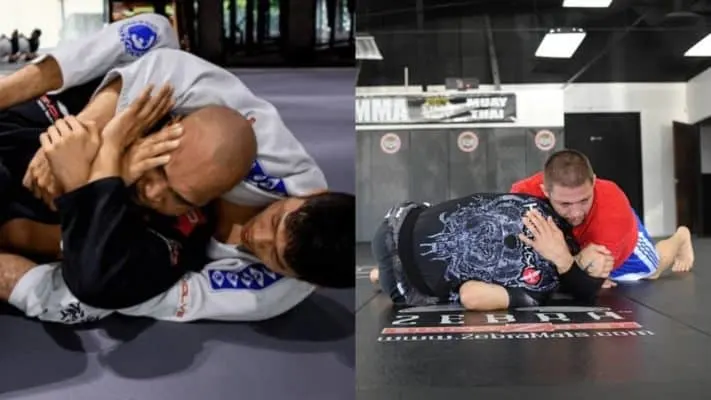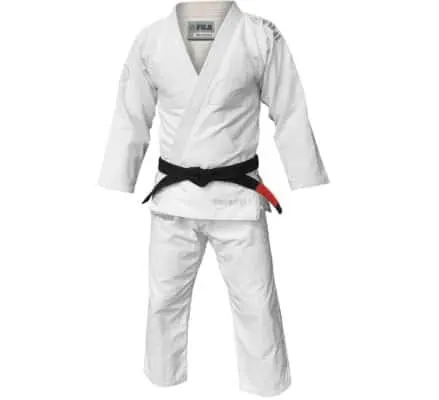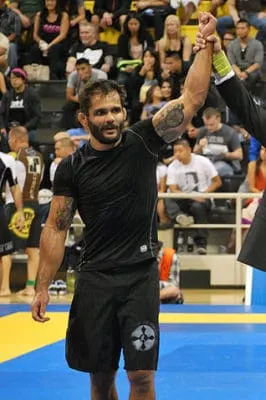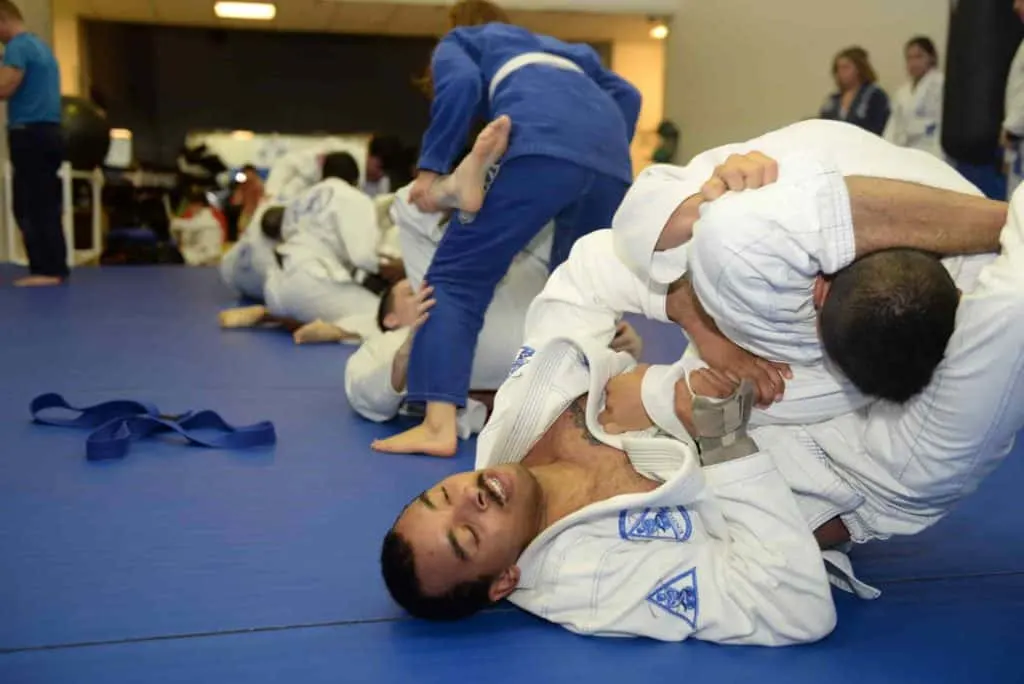
There are countless different practices and disciplines in the world of martial arts to focus on and learn. Even within individual martial arts, there are often subtle or apparent differences that practitioners will need to familiarize themselves with and specialize in. This decision is undoubtedly the case with Brazilian Jiu-Jitsu, as there are two main branches of this discipline: Gi or No-Gi.
Choosing between Gi and No-Gi Brazilian Jiu-Jitsu comes down to preference. Gi Jiu-Jitsu involves combatants wearing the Gi, which allows for grabbing clothing and is more complex. No-Gi Jiu-Jitsu does away with the traditional uniform and is much more similar to street fighting.
This article will go over the many nuanced differences between the two forms to determine the best specialization of Brazilian Jiu-Jitsu (also referred to as BJJ) for you.
What Is Gi Or No-Gi?
The Gi is the name for the traditional uniform worn by BJJ practitioners. The clothing itself is made up of a heavy cotton jacket, reinforced trousers tied with a drawstring, and a belt that denotes the combatant’s rank. The International Brazilian Jiu-Jitsu Federation (IBJJF) enforces many regulations regarding the exact requirements of a combatant’s Gi, outlined below.

- The only colors allowed for international competitions are solid blue, white, or black. However, some jurisdictions relax this rule to allow any single solid color.
- The Gi must be constructed of cotton or equivalent material and be in good condition with no rips or tears and must not be thick or hard to the point that an opponent will be obstructed by it.
- The jacket must reach down to the thighs, and the sleeves must reach to the combatant’s wrist while the arms are extended in front of the body.
- The belt must be between four and five centimeters wide, and the color must correspond to the practitioner’s rank. The belt must be tied securely into a double knot in competitions, tight enough to ensure that the jacket remains closed.
- BJJ athletes will not be permitted to compete if their sleeves or pants are not proper length or with a t-shirt underneath the jacket, except for female participants.
There are many other rules regarding the exact specifications a Gi must adhere to for a formal competition. However, it is worth noting that the Gi is not only the name of the traditional uniform used in BJJ. It also denotes the difference in a practitioner’s fighting style that comes with wearing the Gi.

Photo by Theentropykid
In contrast to the above, No-Gi involves wearing a less strictly enforced uniform of a “rash-guard” top with a kind of athletic shorts underneath. Unlike Gi BJJ, No-Gi BJJ has very few requirements of the practitioner’s clothing, but there are enormous differences in how this variant is practiced relative to Gi BJJ.
RECOMMENDED FOR YOU: What Do BJJ Gi Colors Mean? Answers for BJJ Gi
What Are The Main Differences?
Aside from the uniforms worn, the primary difference between Gi and No-Gi Brazilian Jiu-Jitsu is the types of holds and grapples permitted. BJJ as a martial art is based around controlling your opponent, forcing them into a position where they have to submit to you by eliminating all of their options.
Most rules allow combatants to grab the Gi of their opponent in specific locations in Gi BJJ, most often the sleeves, collar, lapel, and pants. It is worth noting that competitions with rules enforced by the IBJJF may have additional restrictions that limit these options further. Still, those differences will depend entirely on the ruleset used for the competition.
When competing in No-Gi BJJ, there are no “handles” on the opponent’s clothing, and practitioners are usually not allowed to grab their opponent’s clothing at all. This difference means that there is a greater emphasis on balance, body mechanics, and techniques like overhooks to force your opponent to submit without using their clothing to your advantage.
What Are The Technical Differences?
Several technical differences arise from choosing to practice Gi or No-Gi Brazilian Jiu-Jitsu. One of the most well-respected modern BJJ instructors, John Danaher, simplified the differences down to the skills that practitioners develop from practicing one discipline or the other. He stated that the Gi helps develop combatants’ defensive skills, while No-Gi is excellent for building offensive skills. He goes on to state that there are three primary technical differences that No-Gi brings to the table (Bjjsuccess.com, 2020):
1. No-Gi Provides Less Friction
When worn during a competition, a Gi creates a lot of friction, especially as the matches go on and it becomes wet with sweat. This added friction slows down the pace of matches and forces the combatants to wait for opportunities to present themselves and handle each obstacle in turn. In contrast, No-Gi matches are generally more frantic and based around reaction, where speed and strength can be sufficient to overcome lack of technique. These qualities alone are usually not sufficient when wearing a Gi.
2. Fewer Grips In No-Gi
As mentioned above, the thick collar, lapel, sleeves, and pant legs of a Gi provide additional grip opportunities, allowing BJJ practitioners to control their opponents more easily. As stated by Danaher, training in No-Gi ensures that students improve their pinning and submission techniques because they cannot rely on the grips that the Gi provides to do the work for them. This change requires a greater focus on body positioning to render their opponent immobilized when trying to force them to submit.
3. Fewer Stranglehold Chances in No-Gi
The ease with which BJJ practitioners can use the Gi jacket to set up strangleholds forces students to protect their neck and forces beginners to learn the importance of defensive options. There are far fewer stranglehold options in No-Gi BJJ due to the removal of the jacket, and the few that are still available are less effective than they would be in Gi. This point reinforces Danaher’s explanation that No-Gi is ideal for training offensive options as combatants need to have an excellent submission form to combat both the slipperiness of the format as well as the fewer hold options available.
RECOMMENDED FOR YOU: How to Wash White BJJ Gi and Remove Stains
Which Is Better, Gi or No-Gi Jiu-Jitsu?
It is impossible to state whether Gi or No-Gi Brazilian Jiu-Jitsu is better than each other. Both disciplines have numerous reasons for practitioners to develop their skills. If you are considering one or the other, it is often valuable to look into your reasons for learning BJJ in the first place.
There are enormous benefits to be gained from learning a martial arts discipline, and BJJ can provide those benefits whether you choose Gi or No-Gi. The following categories are common questions about which discipline to choose and how each variant will affect practitioners.
Which One Is Better For Beginners?
It is generally accepted that Gi Brazilian Jiu-Jitsu is a better choice for beginners because of the focus on learning proper grips and techniques. Additionally, some BJJ experts state that it is harder to transition from learning No-Gi BJJ exclusively to learning Gi BJJ than to do the inverse.

These experts came to this decision because an enormous part of Gi BJJ is based around traditional hold and grapples, which can be more challenging to learn if you are not familiar with the fundamentals of wrestling in the conventional uniform. Conversely, Gi BJJ practitioners may find the speed and lack of grip off putting in No-Gi BJJ, but the transition is considered more accessible by many.
Ultimately, beginners can learn both disciplines simultaneously. As John Danaher mentioned above, new entrants into the art of Brazilian Jiu-Jitsu will benefit from the nuanced differences between the two styles. The benefit of learning Gi BJJ will provide stalwart defensive capabilities. In contrast, No-Gi BJJ training will provide incredible speed and offensive capabilities that will not require the grips that the Gi provides. Most high-level BJJ practitioners will learn both techniques eventually, so it is worth building a foundation in both styles.
Which Is Better For Self Defense/Street Fighting?
For a long time, most Brazilian Jiu-Jitsu experts’ consensus was that the Gi is unrealistic for real-world self-defense situations. It is improbable that people on the street will be wearing a traditional martial arts uniform. Additionally, the speed and ferocity of No-Gi BJJ are more akin to the frantic scramble that most street fighting ends up becoming. As such, it was often suggested that BJJ students learn No-Gi BJJ if they want to know the discipline for self-defensive reasons.
In recent years, however, there has been a shift of this mindset to consider Gi BJJ’s practical applications in real-world situations. The most obvious reason for this shift is the underlying philosophy that BJJ teaches regarding your opponent’s clothing. Essentially, this philosophy is that any attire, whether it be a t-shirt, a jacket, pants, or anything else, can be used as a weapon against the wearer if you have the understanding of how to use it effectively.
It is worth noting that when Kanō Jigorō introduced the traditional Keikogi (the precursor to the Gi that is used in Judo), it was designed to emulate the every-day clothing worn by the Japanese at that time. Despite the many differences between the dress from over a century ago and modern clothing, the fact remains that it is more likely for a street fight to occur where the participants are wearing some variation of jacket and pants than a spandex outfit as No-Gi BJJ utilizes.
While street clothes are not the same as a Gi in terms of grip, Gi BJJ has become more accepted as an effective self-defense discipline, and BJJ beginners should not choose No-Gi BJJ purely on the principle of using it for self-defense. However, it is worth noting that the grappling and hold techniques that No-Gi BJJ teaches will ensure that practitioners are prepared to handle any type of threat regardless of the clothing worn at the time.
Ultimately, either style will benefit practitioners in a street fight, and it is worth becoming skilled in both formats to provide the most options possible to stay safe in an altercation in the real-world.
RECOMMENDED FOR YOU: BJJ vs Japanese Jiu-Jitsu – Key Differences and Similarities
Is Gi Brazilian Jiu-Jitsu Suitable For MMA?
Gi Brazilian Jiu-Jitsu is not as directly applicable for the MMA ring as No-Gi BJJ. Still, there are benefits from practicing Gi BJJ that translate exceptionally well into the format of mixed-martial arts. The first reason to practice Gi BJJ for MMA training is that it is more prevalent and easy to find than strictly No-Gi BJJ. While there are gyms that specialize in No-Gi, most gyms will have more classes in Gi than not, and as any practitioner will state, the more time spent on the mat, the better.
Additionally, the defensive conditioning that comes from practicing with a Gi cannot be overstated. Many martial disciplines involve training the practitioner with weights, as it improves their speed when the weights are removed. When BJJ practitioners wear a Gi, it creates significantly more friction and makes it harder to escape from specific submissions. If a BJJ fighter can escape while wearing a Gi, removing it will make evading holds even easier.
However, with all that in mind, because MMA involves significantly more striking and often involves rules regarding grappling, the direct application of No-Gi BJJ is more in line with most MMA fights. It is, therefore, most effective to train in No-Gi BJJ but develop skills in the Gi as well to maximize efficacy in the MMA ring. This increased efficacy is why so many top UFC champions over the years have had black belts in Brazilian Jiu-Jitsu and train while wearing the Gi.
In many cases, learning Brazilian Jiu-Jitsu while wearing the Gi encourages technique over raw speed and strength. This practice is essential for MMA fights, mainly because a fighter’s technique will often be the deciding factor in winning a match. Training with a Gi will slow down the bout and force participants to focus on their positioning. This focus on positioning benefits learners who are faster and more athletic than their training partners because it is all too easy to lean on that strength and speed.
The excellent defense that training in a Gi forces BJJ practitioners to learn will force them to use their body position and technique rather than using excessive power to get out of holds from their opponent. Especially if a practitioner is used to being the strongest one in most bouts, this is essential training. They can never ensure that they will always be the strongest fighter in the ring. Relying on raw strength and speed alone is unreliable when going up against the many skilled combatants who participate in MMA.
RECOMMENDED FOR YOU: What is Gracie Jiu-Jitsu? Fully Explained
Should I Focus on Gi?
You should focus on Gi Brazilian Jiu-Jitsu if:
- You intend to learn the fundamentals of BJJ most effectively, and you want a broad range of training applications, both for self-defense and competitions.
- You are interested in transitioning into other martial arts disciplines or moving into No-Gi after building a base capability in Gi BJJ.
Should I Focus on No-Gi?
You should focus on No-Gi Brazilian Jiu-Jitsu if:
- You find the traditional and fundamental aspects of BJJ less enticing, and you intend to focus on MMA applications specifically.
- You intend to learn Gi BJJ only for training purposes, and you don’t intend to compete while wearing a Gi.
To Gi or No-Gi, That Is The Question
While the question of choosing whether to train in Gi or No-Gi is a hotly contested one, the best answer is significantly more straightforward. Gi and No-Gi Brazilian Jiu-Jitsu are two sides of the same coin. For serious competitors in this martial art, you can gain the most benefit from training in both disciplines simultaneously.
Remember that in most cases, training in a Gi will make it easier to transition into practicing No-Gi, and the fundamentals that you learn from the former will benefit you throughout many different disciplines. Look around at your local BJJ gyms and inquire about what their instructors focus on, as it is most beneficial to learn from the instructors that specialize in their chosen discipline. No matter what choice you make, it is never too late to incorporate both sides of the BJJ coin.
